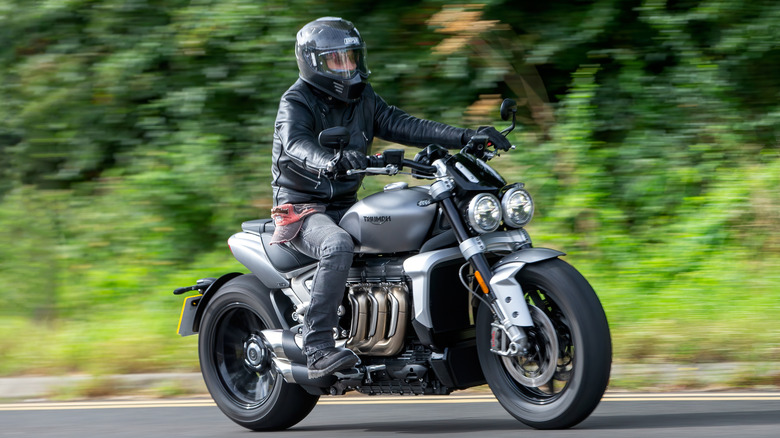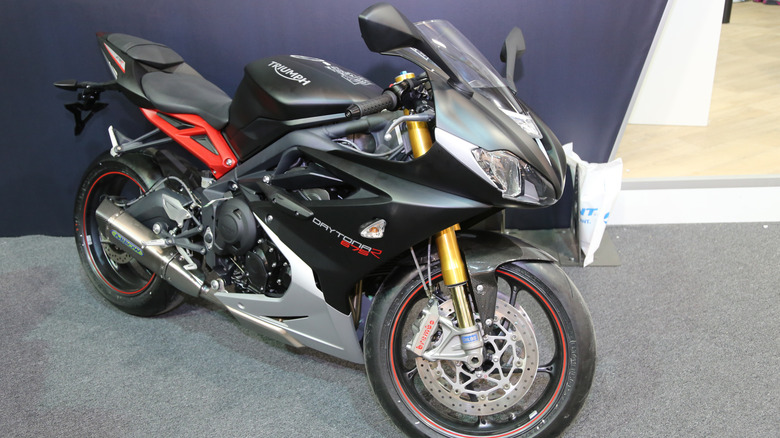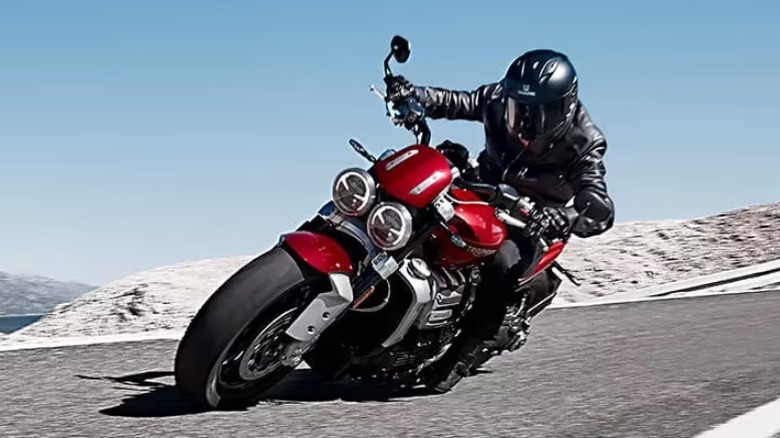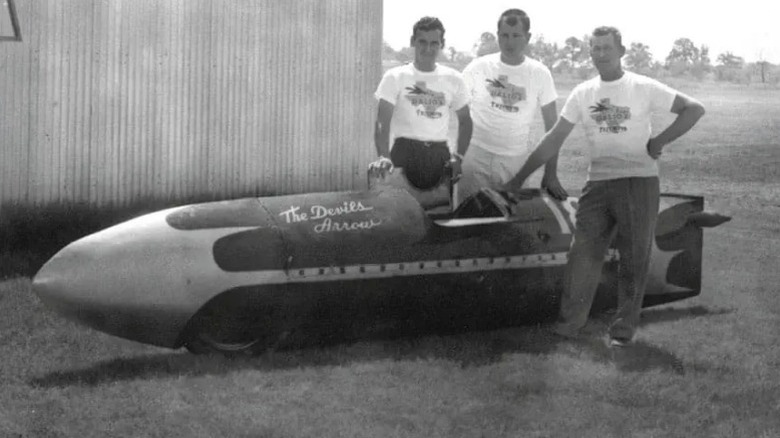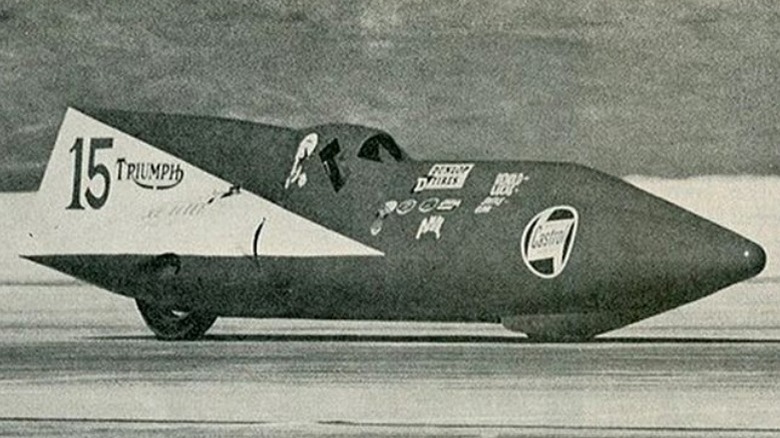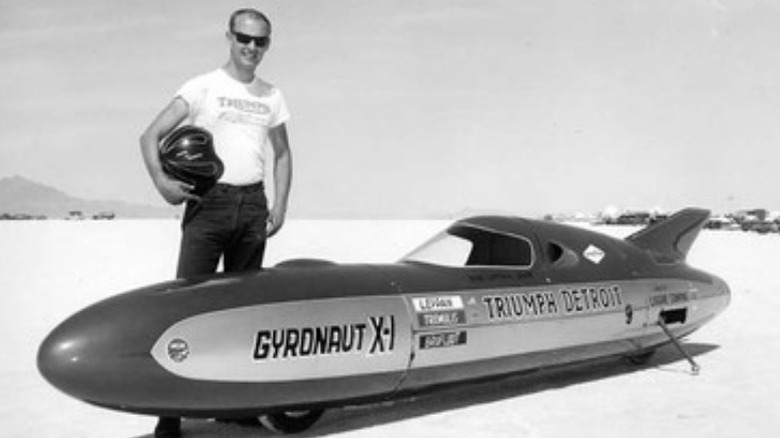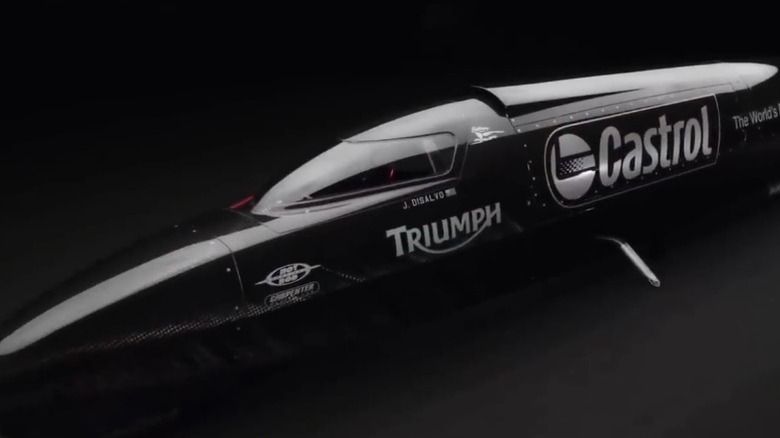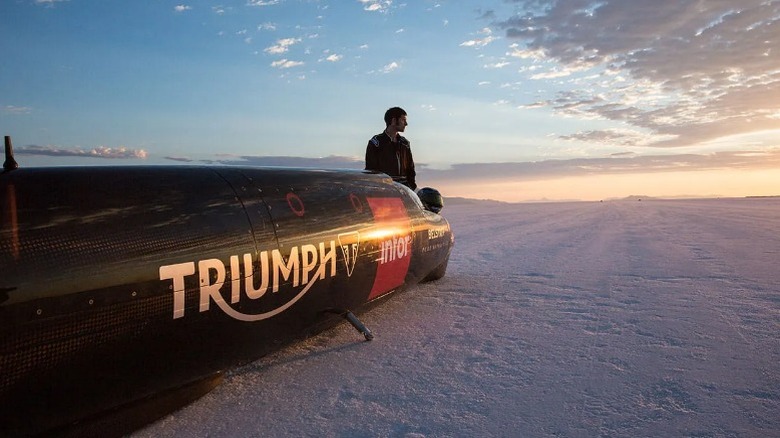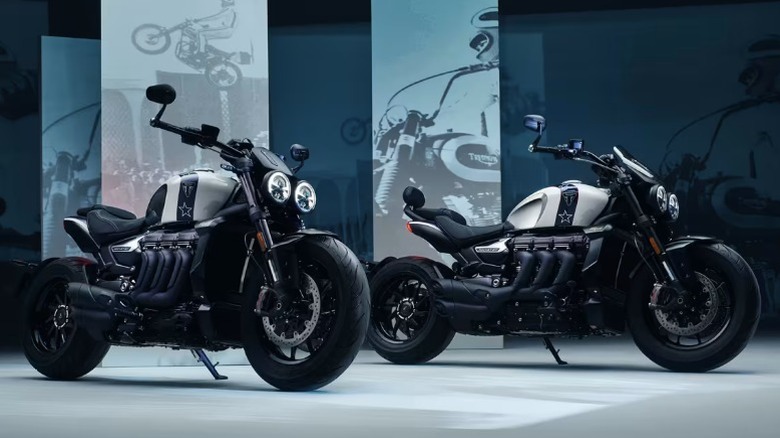7 Of The Fastest Triumph Motorcycles Ever Built, Ranked By Top Speed
Triumph is one of the oldest major motorcycle manufacturers in the world. The U.K.-based company made its first bike all the way back in 1902 and has managed to persevere for over a century through its innovative designs and reputation for reliability. It has made all kinds of motorcycles in that time, from heavy cruisers to off-road adventure bikes. The company isn't exactly known for its supersport models, but it has made a lot of really fast bikes over the years.
There are a few ways to measure speed when it comes to motorcycles. Many who are more concerned with the bike's rate of acceleration will rely on how fast it can go from 0 to 60 MPH, but it's also worth taking a look at the speed where these bikes top out. Triumph has managed to set no less than four different land-speed records in its time. The current record (376.363 MPH) was set by Top Oil's Ack Attack back in 2010, but Triumph has made a lot of impressive machines in this space and has even been working on one that might challenge the Ack Attack for the crown. With that in mind, many fans might be interested in seeing which bikes currently hold the distinction of being the fastest Triumph motorcycles ever made.
7. Triumph Daytona 675 R - 165 MPH
Triumph currently makes only one sports bike, the Daytona 660. This is certainly an impressive machine, with a more than respectable top speed of 134 MPH. That's plenty of power for most riders, but it isn't the biggest or fastest version of the Daytona that the company has ever put on the market.
That honor goes to the Triumph Daytona 675 R. This is an upgraded version of the original Daytona 675 and is actually the single fastest mass-produced 600cc motorcycle ever made, narrowly edging out contemporaries from Kawasaki, Augusta, and Yamaha. The bike was in production from 2013 to 2018 and absolutely dominated the midrange in terms of raw power. It had a 675cc, DOHC, inline 3-cylinder engine. This was a distinctly different design from the smaller bore, 4-cylinder engines that have been used by most other midrange supersports in recent years. It could put out 126 horsepower at 12,600 RPM and could produce up to 55 lb-ft of torque at 11,700 RPM. "Higher engine speeds mean more peak power, but a more efficient cylinder head and more precise fueling mean there's more torque, too," writes Ari Hennig of Motorcyclist. "The midrange feels as robust as ever, and while short-shifting is still an advisable strategy, the new motor has more usable over-rev than before, addressing what was one of a very limited number of complaints I had about the Triumph's engine."
All this added up to a bike that was able to hit a top speed of 165 MPH, earning it a place among the fastest Triumph motorcycles ever built–an impressive feat considering most of the bikes on this list were never available for public consumption.
6. Supercharged Triumph Rocket 3 R - 176 MPH
The other production motorcycle to make the list is the Supercharged Triumph Rocket 3. Many fans were surprised when the Rocket 3 first launched, as it's stylistically closer to a lot of American motorcycles than it is to most of the other bikes made by the U.K.-based manufacturer. It's big, long, and houses a colossal 2,500cc, 3-cylinder engine that can produce up to 163 lb-ft of torque and can get up to approximately 140 MPH, while the newer Rocket 3 Storm tops out at 138 MPH.
"This bike still exudes an intimidating presence—it says '2,500cc' right there on the side of the engine—but it doesn't require an expert drag racer to get the most out of it," says Morgan Gales of Cycle World. "The huge engine matched to sorted fueling produces clean and usable power, no matter the situation." So speed and acceleration are just part of the reason the Rocket 3 is counted among the best Triumph motorcycles ever built, but there's an even faster version of it out there.
This might be a bit of a cheat, but TTS Performance designed a supercharge kit specifically for the Triumph Rocket 3 that can increase its already considerable metrics to over 340 horsepower and 270 lb-ft of torque. Reports from the company claim that Rocket 3 Rs that have been equipped with the kit can run a quarter mile in 10.0 seconds, finishing at 158 MPH, and that they can achieve a top speed of 176 MPH. So while this particular version of the bike isn't exactly a stock vehicle, it's hard to deny that the Supercharged Rocket 3 lives up to its name.
5. Triumph Bonneville Streamliner (Devil's Arrow and Texas Cee-Gar) - 193-214 MPH
The first land-speed record was set in 1924 when Malcolm Campbell's Bluebird managed to get up to 146 MPH on the Pendine Sands. This record has changed hands a few times over the years, but one of the more memorable of these victories was in 1955 when Texas racer Johnny Allen rode the 15-foot-long Triumph Devil's Arrow Streamliner on the Bonneville Salt Flats in Utah. This bike managed to set a new record by reaching a monumental 193 MPH. The bike was powered by a methanol-fueled 650cc, turbo-powered engine.
Allen and his service manager, Jack Wilson, didn't stop there, though. They continued to work on the bike and improve it even further. The 193 MPH record speed was quickly broken by a German NSU Moterenwerke team within a few months, but Allen and Wilson returned to Bonneville in 1956 with a new version of the Streamliner, which was code-named "the Texas Ceegar." In it, Allen managed to hit 214 MPH–a colossal feat for a motorcycle built almost 70 years ago and a record that held until 1962.
Both versions of the Bonneville Streamliner were so popular that they inspired Triumph's chief designer, Edward Turner, to create an entire line of motorcycles named after them that would be available for mass distribution. Thus, the T120 Bonneville was born in 1959 and the iconic line of Triumph Bonneville motorcycles first began.
4. Dudek Streamliner - 225 MPH
The third time Triumph took the record was when aircraft mechanic Joe Dudek created a truly innovative design by combining the aerodynamics of an X-15 rocket-powered plane with the bored-out engine of a T-120 Bonneville. The result was a bike that came to be known as the Dudek Streamliner.
This motorcycle was piloted by Bill Johnson and has the distinction of claiming two different records. It first won the record for being the fastest gas-powered motorcycle of its time with a top speed of 205 MPH, which would be impressive enough on its own, but they didn't stop there. The team removed the gasoline and swapped out the carburetor jets, turning the Dudek Streamliner into a machine that could run on nitro methane. With this new and much more combustive fuel in the tank, Johnson was able to get the bike up to the new record-breaking top speed of 225 MPH in September 1962 -– a feat that was confirmed by the AMA.
Sadly, the Dudek Streamliner was destroyed in a fire in 1974, but its legacy remains. That said, its record didn't last long.
3. Triumph Gyronaut X-1 - 246 MPH
Next up is the company's last record-breaking machine: The Triumph Gyronaut X-1. Detroit Triumph dealership owner and renowned drag racer Bob Leppan built this fantastic vehicle in 1966 with the assistance of Alex Tremulis and Jim Bruflodt. Like the Dudek Streamliner before it, this machine looks more aircraft than motorcycle. That's actually quite fitting when you consider that its conception happened to coincide with the space race–when nations all over the world were looking on in awe at the wonders of modern engineering.
The Gyronaut X-1 might not have made it to the moon, but it did set a land-speed record that surpassed the previous record by nearly 20% when it managed to achieve a top speed of 245 MPH. That isn't to say that riding it at that speed was exactly smooth sailing, though. "When things are correct, it's a great ride, but when things don't go well, it's absolutely terrifying," Triumph quotes Leppan as saying. "On my second run I thought, 'If I'm going to crash it, I'm really going to crash it. This is it!' Of course, there's fear, but you have to work your way past it."
Part of how it did this was by stripping back the weight and running with the absolute bare minimum amount of materials. This was how they were able to set such an impressive speed record with an engine that produced just 130 horsepower. Later streamliners found that you need a bit more weight to hold you down to the salt to achieve even higher speeds, though.
2. Triumph Castrol Rocket 3 - approx. 200-400MPH
It's possible that the Castrol Rocket 3 is the fastest motorcycle that Triumph has ever made -– though it's impossible to say exactly how fast this motorcycle actually is. The twin Rocket, carbon fiber Streamliner was designed to be piloted by American Grand Prix racer and Daytona 200 winner, Jason Di Salvo. "Piloting the Triumph Castrol Rocket is a unique and thrilling challenge, but what really stands out is the unbelievable amount of power the machine produces," said Di Salvo (via Cycle World), "It simply defies explanation and belief. I find myself tapping into all the honed skill I have developed in my racing career and learning new ones as we continue to eclipse new speed levels."
The project started in 2014 and was produced by Triumph Motorcycles' North American branch. The Castrol Rocket 3's twin engines were designed by Bob Carpenter of Carpenter Racing in coordination with Matt Markstaller of Hot Rod Conspiracy who took care of the Carbon Kevlar monocoque bodywork, and several of Triumph's own engineers. It was powered by two methanol-fueled Triumph Rocket 3 1485cc engines which gave it over 1,000 horsepower in the rear wheel.
Triumph seemed confident in the vehicle's ability to break the record and even approach 400 MPH, but unfortunately, the opportunity never manifested. Weather conditions on the Bonneville Salt Flats were unsuitable for during both of the team's attempts in 2014 and 2015. This put the project on an indefinite hold, and leaving many to wonder just how fast the bike actually is. But without a verified top speed, it's impossible to say if it's actually faster than the company's current number one.
1. Triumph Infor Rocket Streamliner - 274 MPH
The Triumph Infor Rocket Streamliner did not break a land speed record. It wasn't created until after the Castrol Rocket 3 and well after the Top Oil Ack Attack had already set its monumental record in 2010. The Infor Rocket never really got close to that 376 MPH threshold, but that doesn't change the fact that it's very, very fast. This model was designed by Guy Martin and its creation was thoroughly recorded in the documentary, "Guy Martin: Fastest Man on Two Wheels?" which first aired on the Velocity network back in 2016.
There were several preliminary runs where the Infor Rocket managed to clear 200 MPH with relative ease. The team was optimistic about its chances. During its final run, where Martin attempted the Ack Attack's record, they ran into some trouble. The massive bike, which was powered by twin turbocharged and methanol fueled engines, started to fishtail somewhere in the 190 MPH range. Martin managed to correct the imbalance and pushed the throttle even further. This took the Infor Rocket to its fastest recorded speed: 274 MPH. After the run, the team realized that there was something wrong with the bike, though it doesn't appear that they were able to verify the exact source of the problem and ultimately decided it was unsafe to continue. Even so, it still holds the fastest top speed ever set by a Triumph motorcycle.
Our methodology
I have been riding motorcycles for over 15 years and have been working on them for just as long, which has given me a comfortable understanding of motorcycle mechanics. In constructing this list, I started by consulting land-speed record attempts in order to verify which of the Triumph motorcycle models have put forth the fastest top speeds in the company's history, regardless of whether they were able to set a record at the time. I then compared these to the top speeds of the company's fastest production models and chose the seven bikes with the highest speeds that it has ever made.
Once I had my list, I researched each of these bikes to get more information about how they were constructed, who was riding them, and what kinds of modifications were made in order to give them their best times. I then ranked them by top speed, using my best judgement in terms of placement when speed was not officially verified.
